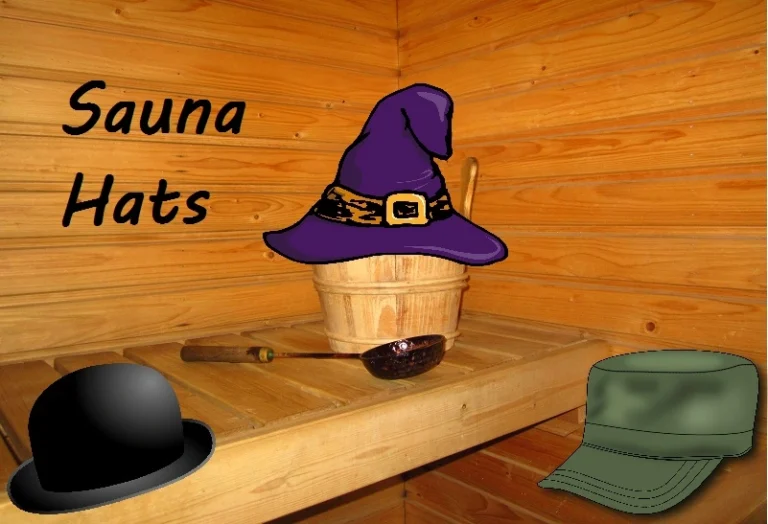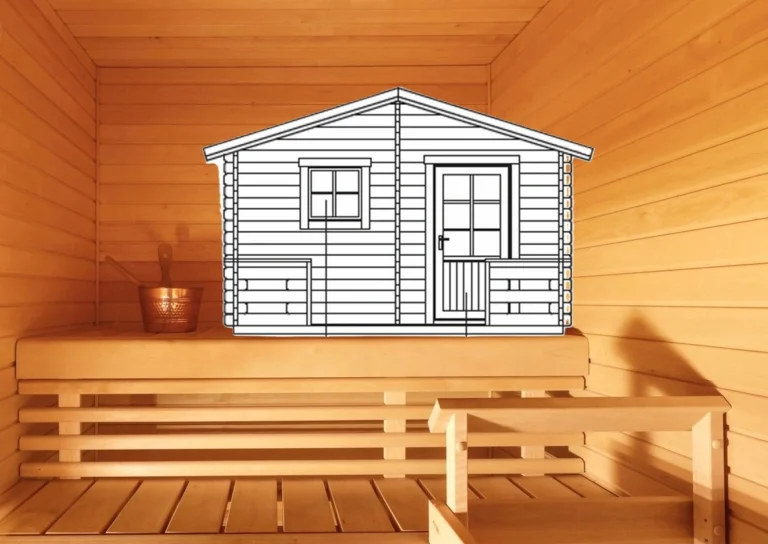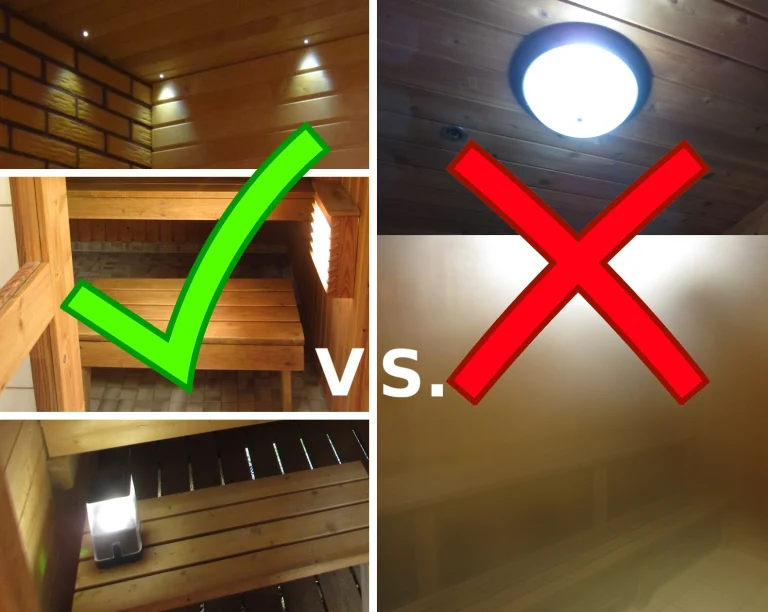Dry Sauna vs. Wet Sauna: 2 Infuriating Sauna Lies
Let me guess.
When you google dry sauna vs. wet sauna, you not only want to know what these concepts mean and the differences between them, but you’re also interested in knowing which one is better and which one you’d prefer either at the gym or as a home sauna.
If that’s you, it’s understandable to want to know these things. The only problem is that most sources writing about dry sauna vs. wet sauna get it all wrong.
It’s because their sauna knowledge is very limited, in fact, much poorer than most readers even realize.
What does that mean for you? You end up wasting your time, trying to take in info that makes no sense, and still not knowing which type of sauna you’d like best!
I’m going to change that today with my sauna expertise of 35+ years.
Let’s uncover what a dry sauna and wet sauna are, what they aren’t, and make sure you finally get all the answers you need and no more BS.
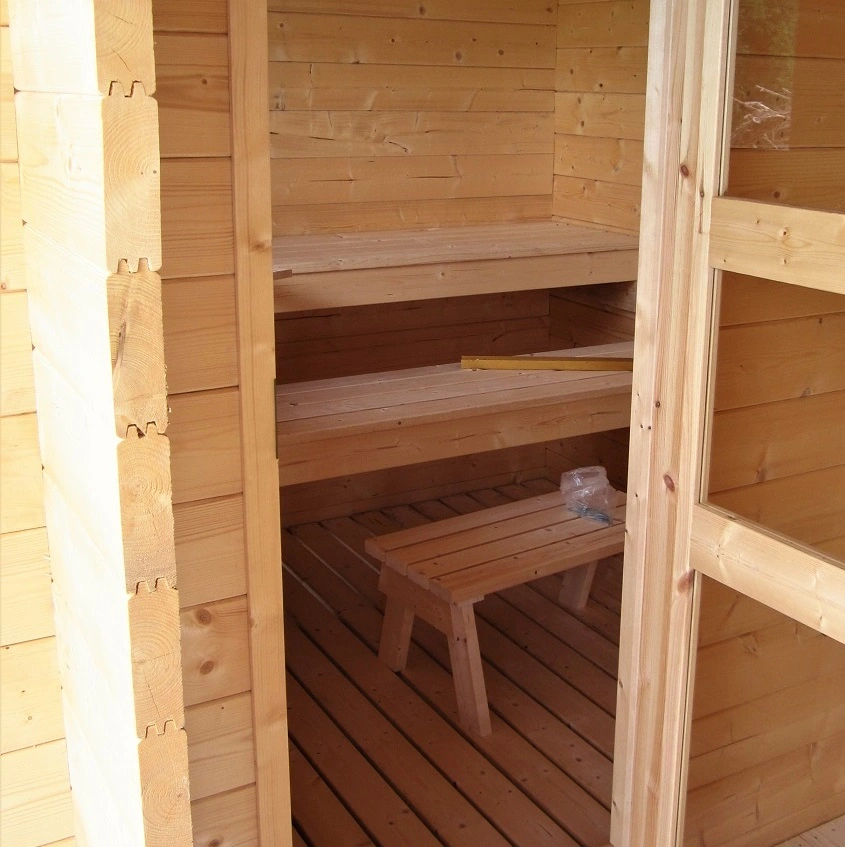
Which is better, a dry or wet sauna?
It’s generally claimed that a traditional sauna is a dry sauna while a steam room is a wet sauna, but this claim is false.
A steam room isn’t and has never been a sauna by definition. This is easily seen in practice too: very few if any gyms and spas that offer both saunas and steam rooms speak of their selection as “dry and wet saunas” because they know better. Why confuse people for no reason?
A steam room has a steam generator pumping out steam, much lower temperature than sauna (up to 120 F), and very high humidity (around 100%).
A steam room is only a “wet sauna” in some people’s everyday vernacular, meaning it’s a “sauna” like jellyfish is “fish” (in reality, it’s not fish but an invertebrate).
While you’ll find steam rooms in spas and some gyms, they’re much rarer and less sought-after than saunas for home use.
So, unless you really want a steam room, we can now cross out “wet saunas” and move on!
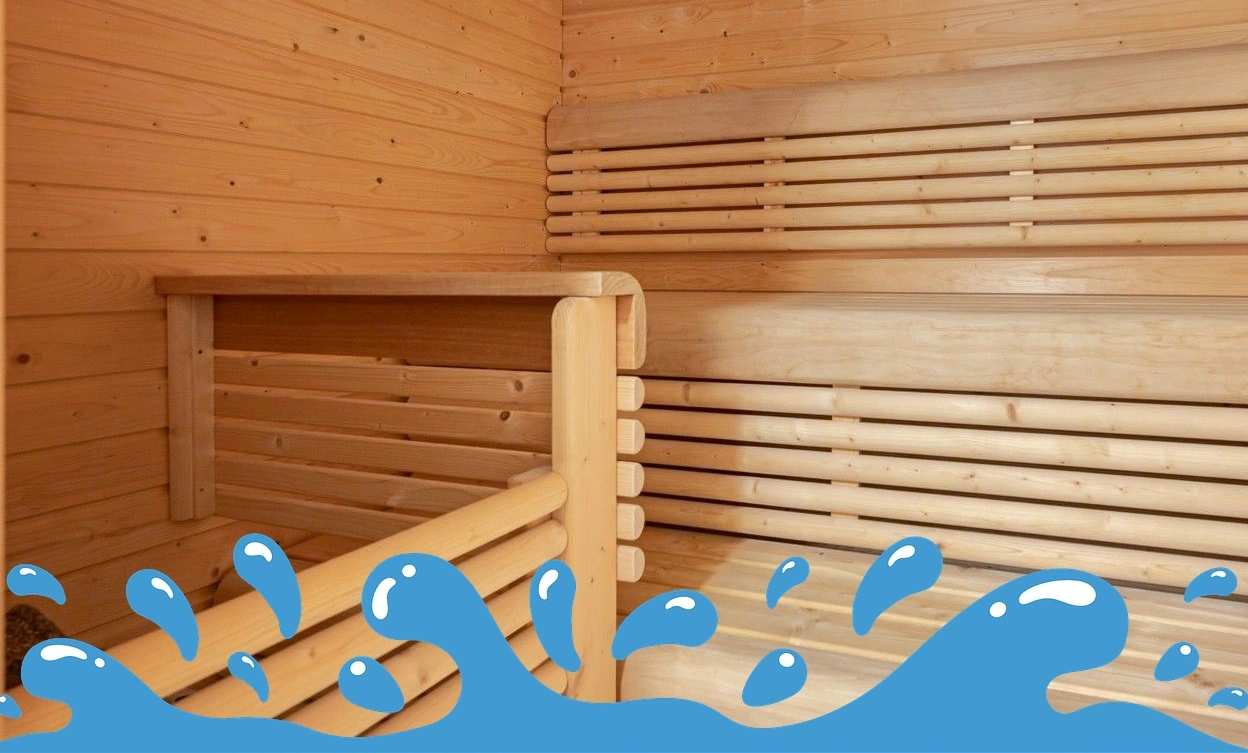
What about dry saunas, then? Surely they’re a thing?
Nope. If you thought “wet saunas” being steam rooms wasn’t bad enough, brace yourself for what’s to come with “dry saunas.”
Most typically, what’s considered a “dry sauna” is in reality a traditional sauna used incorrectly.
Traditional saunas, both indoor and outdoor, and regardless of their sauna heater type (electric or wood-burning), are meant to be used with lots of water that you pour on the hot sauna rocks.
That water turns into steam (löyly) that is the whole point of saunaing. Every saunaing nation knows and agrees on this. Even the Japanese are learning how to pour löyly, inspired by the Finnish.
How a sauna that’s ALL ABOUT the steam could be a “dry sauna” is an oxymoron more people should be aware of.
So, now that you know the question are dry or wet saunas better is contradictory and impossible to answer, let’s translate it to what most of you probably intended to ask:
- Which is better, a traditional sauna or a steam room?
- Which is better, a traditional sauna used as dry or wet?
These questions not only make sense but can also be answered more objectively.
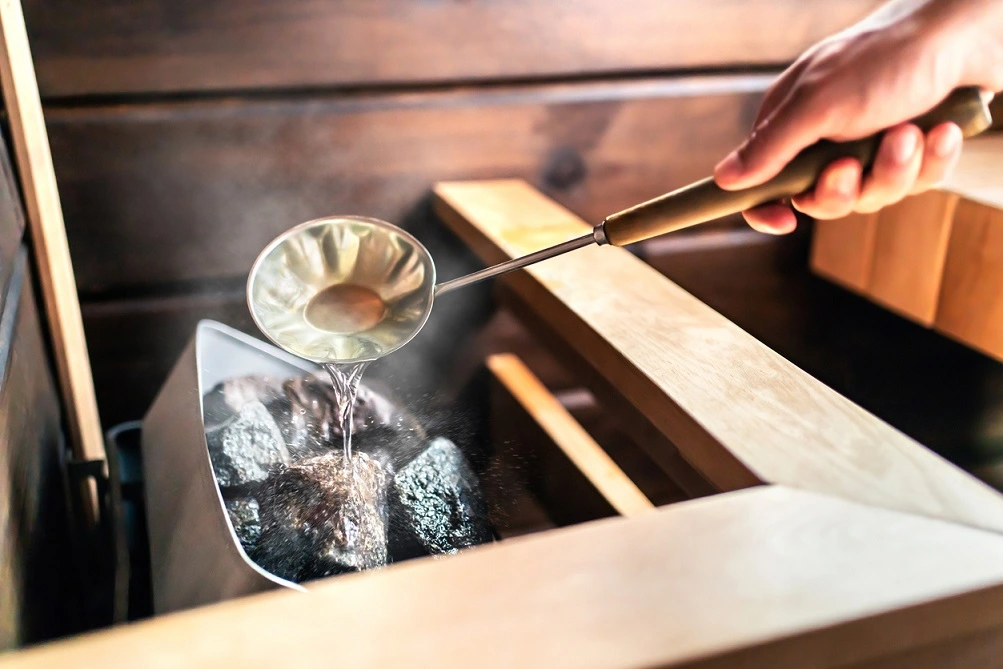
Sauna vs. Steam Room
A traditional sauna used in the correct way (= by pouring plenty of water on the sauna rocks) often beats a steam room simply because it’s more versatile, much less likely to get moldy, and easier to install to your home or yard (less/no tiling needed, easier waterproofing, etc.).
A steam room can’t be turned into a sauna but a sauna can be turned into a steam room: you can get a combination sauna heater that functions as a regular heater in addition to having a built-in steam generator.
A sauna also offers much better and wider temperature control than mere steam rooms.
Dry Sauna vs. Wet Sauna (= Using a Traditional Sauna Either Dry or Wet)
What about the other question, i.e., should you use a traditional sauna as dry or wet?
This is like asking an American should you eat a burger with all the patties, cheese, and dressings (= wet), or without all of them, meaning you’d eat only the bun (= dry).
First of all, nobody would choose the dry bun, and second of all, it wouldn’t even be a burger if you removed everything that makes it a burger!
This is exactly how it is with saunas too: sauna isn’t a sauna without steam (löyly).
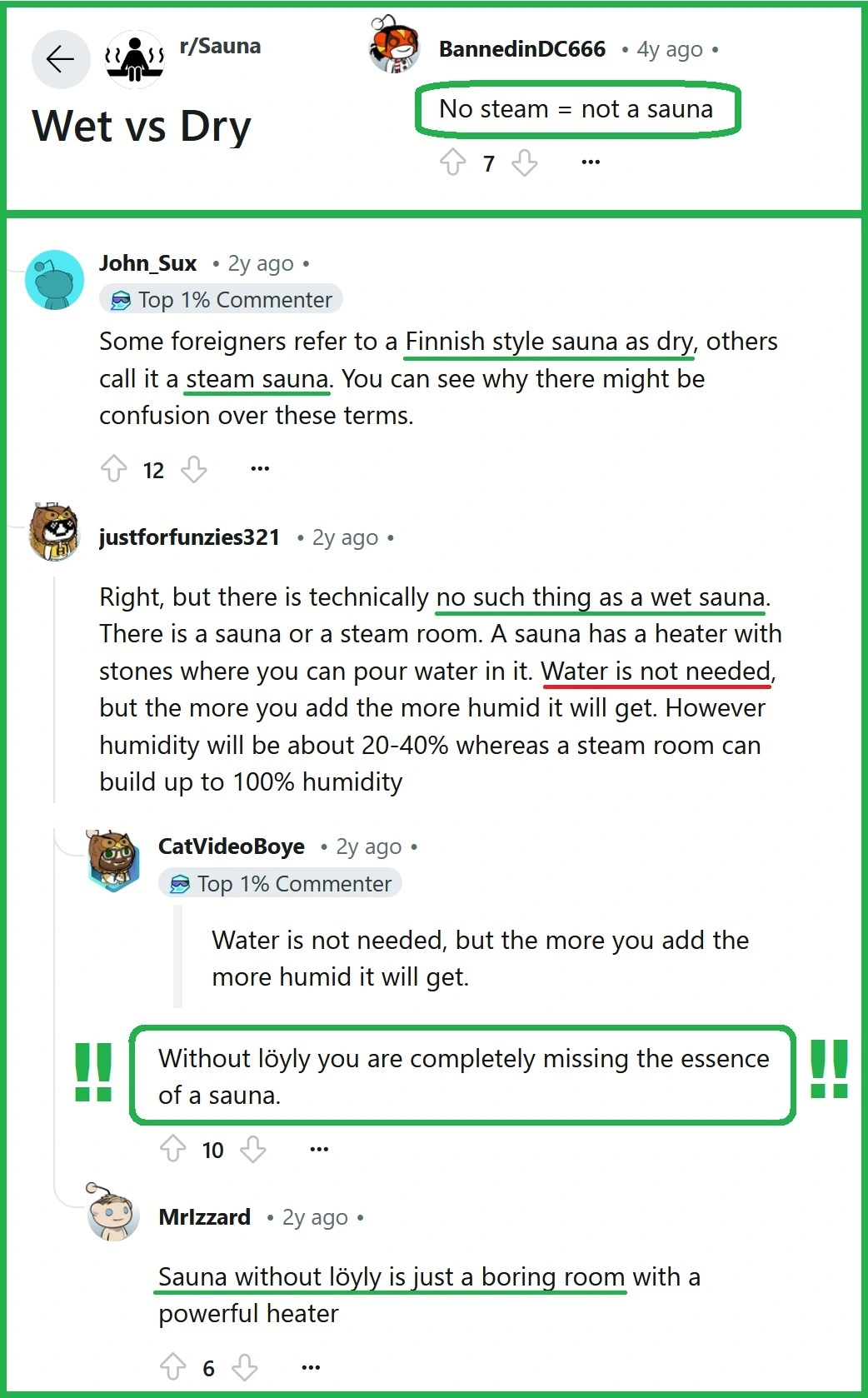
It’s a common misconception that throwing water on the sauna rocks is just an option. What’s nearly as common is thinking that you should only splash a little water, not pour or throw, but both beliefs are incorrect.
You won’t be getting proper löyly with just a little splashing, and many sauna heater brands specifically say how necessary throwing water is.
Any real sauna heater handles water perfectly, so don’t be afraid to throw several ladles at a time. If you have a sauna water bucket filled, it’s realistic to use all that water during a 30–45 minute sauna session with breaks.
Just remember to never have anything on top of the heater when pouring water. That’s why sauna ladles have long handles; it’s the ladle that gets closest to the heater, not your hands or body.
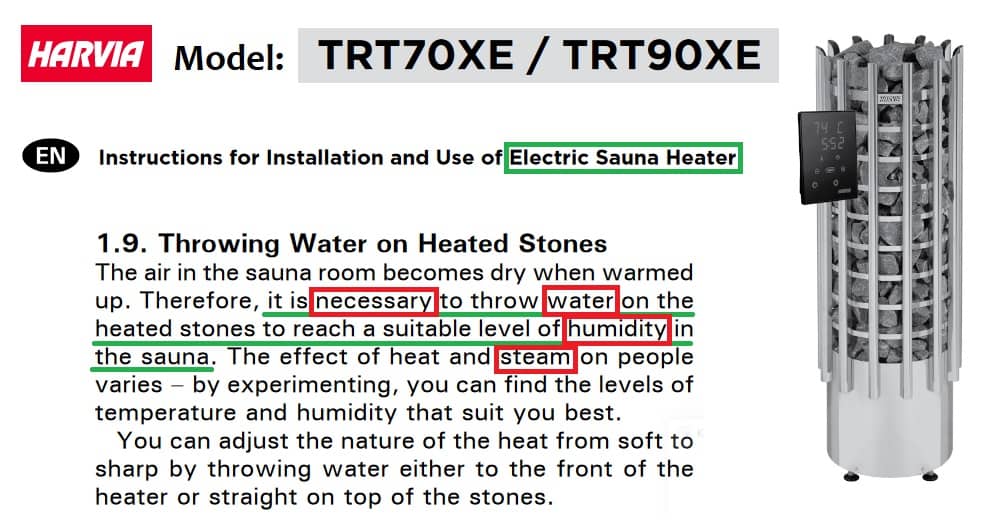
Common Misconceptions about Dry sauna vs. Wet Sauna Health Benefits
On my About page, I write about the huge gap that exists between people and nations that sauna a lot (and have done so for centuries) and those people who have only recently been introduced to saunaing.
The former group knows how to sauna so well they could do it in their sleep while the latter group struggles even with the basics.
Not knowing how to sauna would be totally fine since it’s not realistic to expect top-notch sauna info from amateurs, but what makes it problematic is that far over 90% of everything sauna-related online has been written by the latter group!
That’s why we have so much sauna misinformation online, and it’s particularly emphasized with dry sauna vs. wet sauna debacle.
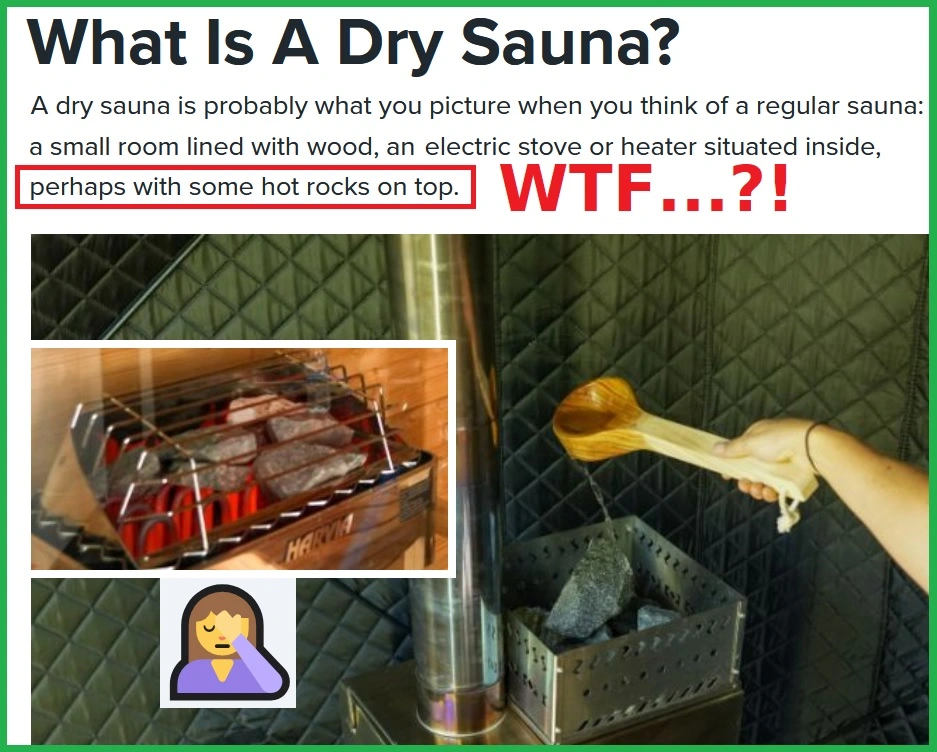
In this horrific scene by Garage Gym Reviews above, we have a practically empty Harvia sauna heater in use, with the bare heating elements gleaming because they’re not surrounded by rocks. Rocks are NEVER optional! My similar or identical Harvia heater requires 45 pounds of rocks.
The other heater on the right also has a pitiful amount of rocks and not nearly enough space for rocks in general, which is exactly why I don’t recommend it in my sauna tent article.
Rocks and steam (löyly) go hand in hand, so if sources don’t understand the meaning and purpose of sauna rocks, it’s no wonder their dry sauna vs. wet sauna ideas are wacky beyond comprehension.
It’s typical for these uninformed sources to list dry sauna benefits and wet sauna benefits separately even when they’re mostly claimed to be the same.
Usually respiratory and skin care benefits are credited to only “wet saunas” since the steam can help with breathing, clearing the airways, and with certain skin conditions.
But once again, this is all wrong for the same reason it was above: a traditional sauna is not meant to be used dry, and when you use it correctly, you get the best of both worlds, all in one.
A traditional sauna used correctly (= water thrown on the hot sauna rocks to produce steam)
- improves cardiovascular health
- lowers risks of dementia and Alzheimer’s disease
- relaxes, reduces stress, and improves sleep
- helps alleviate symptoms of common colds, asthma, and chronic bronchitis
- relieves sore muscles, joint pain, and arthritis symptoms, reducing inflammation
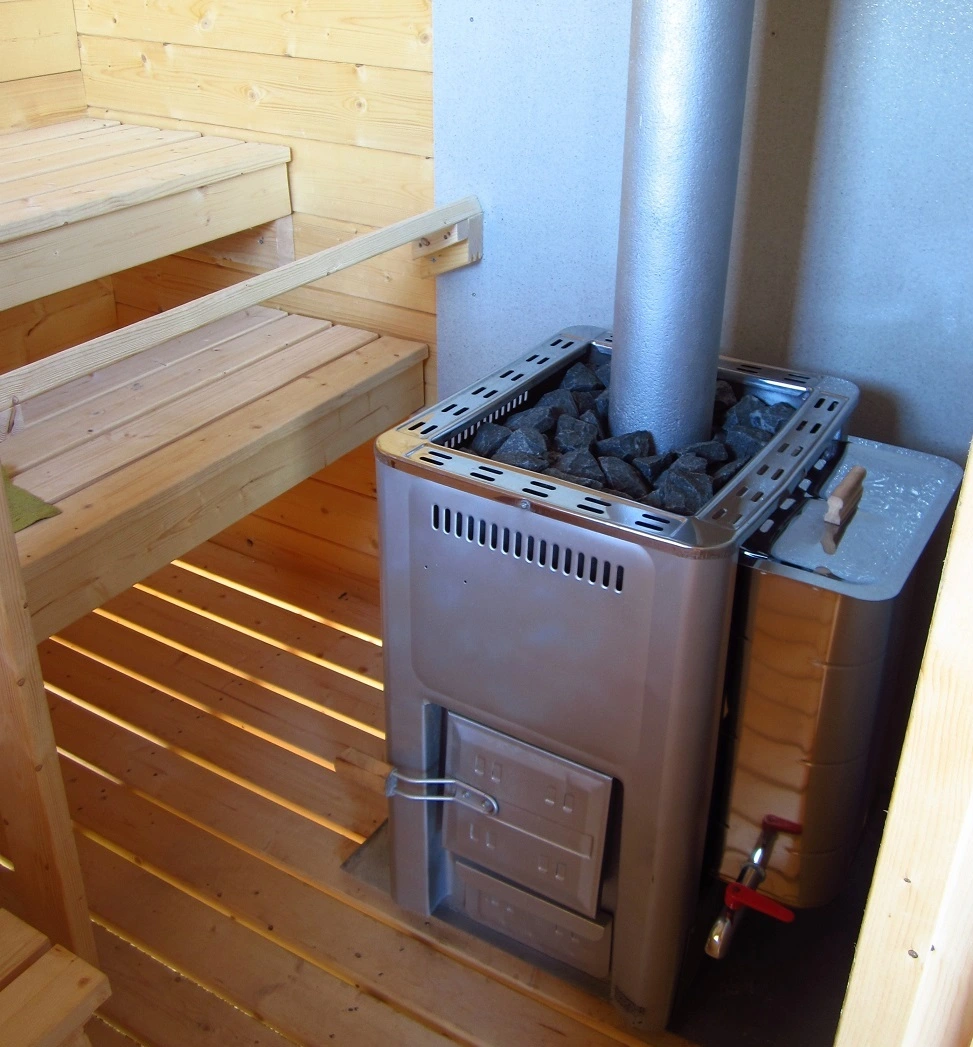
3 Major Problems with “Dry Sauna Benefits”
1. Artificially limiting the benefits
As a traditional sauna used correctly is much more wet than dry, you’re limiting the benefits with incorrect use (= not throwing water and enjoying the steam).
2. Misuse of saunas won’t necessarily bring you benefits
If you’ve heard about the best and most quoted sauna studies that lasted for decades and had thousands of participants, you may want similar health benefits for yourself.
And if you know all the participants used traditional “dry saunas,” thinking it means saunas are used dry, then you’re not using the sauna like ALL the participants did.
In Finnish studies, “dry saunas” are never used dry! That’s exactly why dry sauna is the worst possible descriptor for a traditional sauna.
So, if you wish to replicate the research settings in your own sauna use, steam (löyly) is a must.
As saunaing without löyly is not only unpleasant but also boring, it’s impossible to say whether you can get the same benefits as the participants when you’re the only one “enjoying” your sauna sessions dry.

3. Compensation & cost
Whenever you use your sauna dry, you may feel forced to go for higher temperatures as dry heat is easier to bear than steamy heat.
This means you have to compensate for the lack of steam with more heat. If you threw water, you’d get steam that would also make the sauna room feel hotter.
Not taking advantage of steam wastes energy, be it electricity or wood, and having to heat the sauna excessively taxes your sauna heater, shortening its lifespan.
Frequently Asked Questions (FAQ)
1. What is the point of a dry sauna and what does a dry sauna do?
If your understanding of dry sauna is that it’s a traditional sauna used dry (this belief is very common in the US), then there is no point to it. This kind of dry sauna is a traditional sauna used incorrectly.
But, when used just as a synonym for a traditional sauna, then a dry sauna is mostly used for enjoyment as it’s very relaxing and has many health benefits, such as improved cardiovascular function, stress reduction, better sleep, pain relief, and faster recovery after exercise or injury.
2. How long should you sit in a dry sauna?
Your heart rate starts to increase most significantly (which is good for healthy individuals) after 15 minutes of saunaing, which means that if you stay in the sauna for less than that, you’re potentially not getting the most health benefits regarding circulatory health (Laukkanen et al., 2020, p. 34).
The vast sauna study with 2,315 men, monitored for almost two decades, showed that the group that had the least heart issues, saunaed for at least 19 minutes straight per session.
And remember, these results weren’t achieved in a “dry sauna” (= no water use) but included plenty of steam (löyly)!
3. Do you wear clothes in a dry sauna?
In a home sauna: no, you never wear clothes.
In a public Finnish sauna in Finland: in single sex saunas, no, you never wear clothes. Saunas meant for both sexes usually allow clothes.
In a public “Finnish” sauna in the US: yes, feel free to wear clothes just like everybody else. Not because it’s a good idea (in reality, it’s a terrible idea) but since everybody is doing it wrong, you might as well, or otherwise you’ll be the only naked person there.
In the US, don’t expect löyly as most public saunas are used incorrectly.

4. Dry sauna vs. wet sauna for weight loss, which is better?
Saunaing leads to temporary water loss as you sweat, not fat loss which is what people usually mean when they want to lose weight.
To really lose weight (= fat), that won’t happen in any type of sauna.
5. What is the healthiest type of sauna?
According to actual data, traditional saunas are the healthiest as they have existed for the longest (thousands of years) and therefore have also been studied the most.
Infrared “saunas“ are notorious for wildly exaggerated health claims with no proof.
Whenever you hear an infrared “sauna” is the healthiest, that “information” is coming from unethical salespeople profiting from you, not from researchers and cardiologists like with so many Finnish studies that always focus on traditional saunas.
6. Can you pour water on electric sauna?
Yes, absolutely. All real sauna heaters, electric or wood-burning, either require you to throw water or strongly recommend it.
On this very post, you can see examples of two electric heaters, one from Harvia and the other from Mondex, both telling you to throw water.
The idea that you would sauna without throwing water (löyly) is unheard of and pure lunacy in countries like Finland where saunaing is part of life.
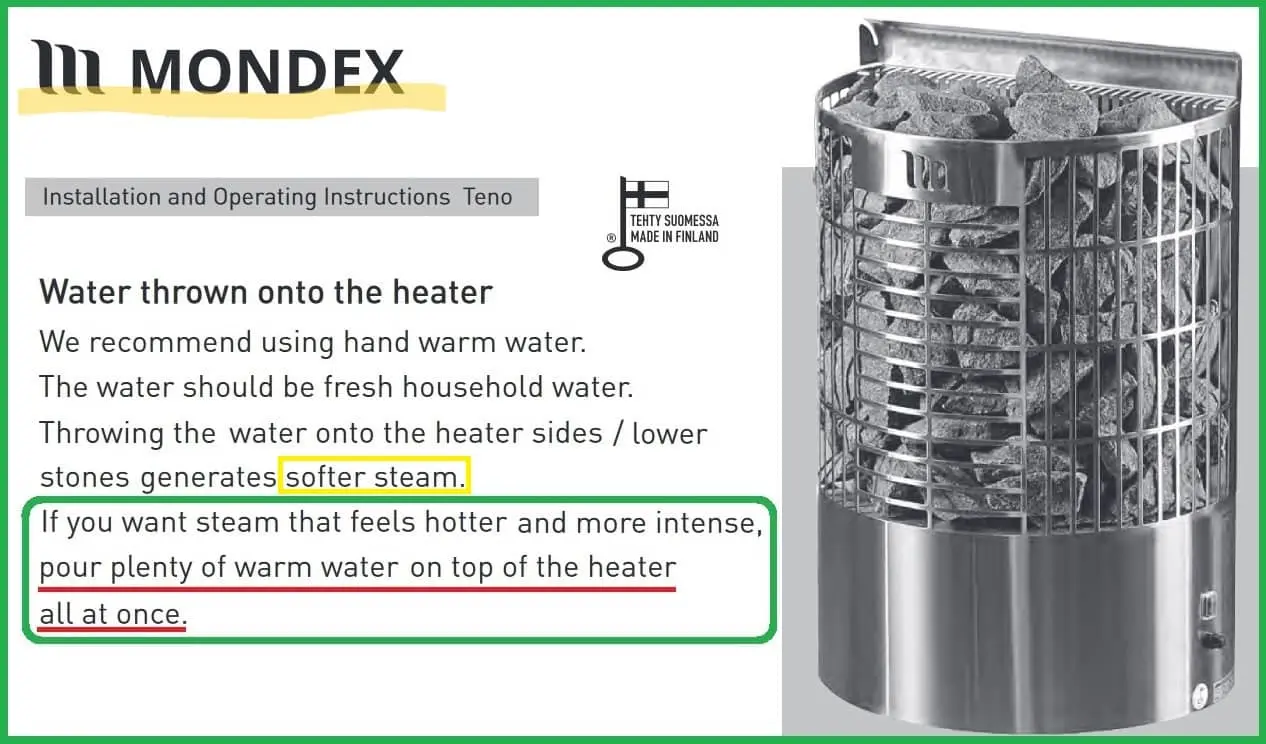
Final Thoughts
The main problem with the term dry sauna is that people new to saunaing take it too literally, thinking that a sauna is used dry.
That is the biggest mistake anyone can make with saunaing as sauna is ALL about the steam (löyly).
And like shown in this article, steam (löyly) is not just an option that some people like and some don’t. Sauna heaters are designed and built for water use, which is exactly why it’s often specified in the instructions that throwing water is a necessity.
How much or little water you throw is of course up to you, but if you think that you just “prefer” a dry sauna with no water use, it’s much more likely due to a misunderstanding than an actual preference.
This is likely because it’s generally known the majority of people in saunaing nations prefer slightly milder temperatures (around 175 F (80 C) or lower) and lots of steam.
I’ve heard only a select minority (mostly previous sauna competitors) say that they prefer higher heat and slightly less steam.

This is reflected in the extensive sauna heater selection too: the models with emphasis on sauna rocks for maximum steam production are the most popular.
In fact, how you assess how good your sauna heater is and whether you’re happy with it or not, depends all on how great a löyly you can get with it.
When steam (löyly) is the whole point of saunaing and the most important thing your sauna heater has to be able to deliver, it’s frustrating to have to witness so much “dry sauna” nonsense online.
If I were invited to a traditional “sauna” where throwing water wasn’t allowed, I would pass (and so would every other sauna-goer I know).
Book source:
Laukkanen, Tanjaniina, & Laukkanen, Jari (2020). Sauna, keho & mieli. Docendo.


